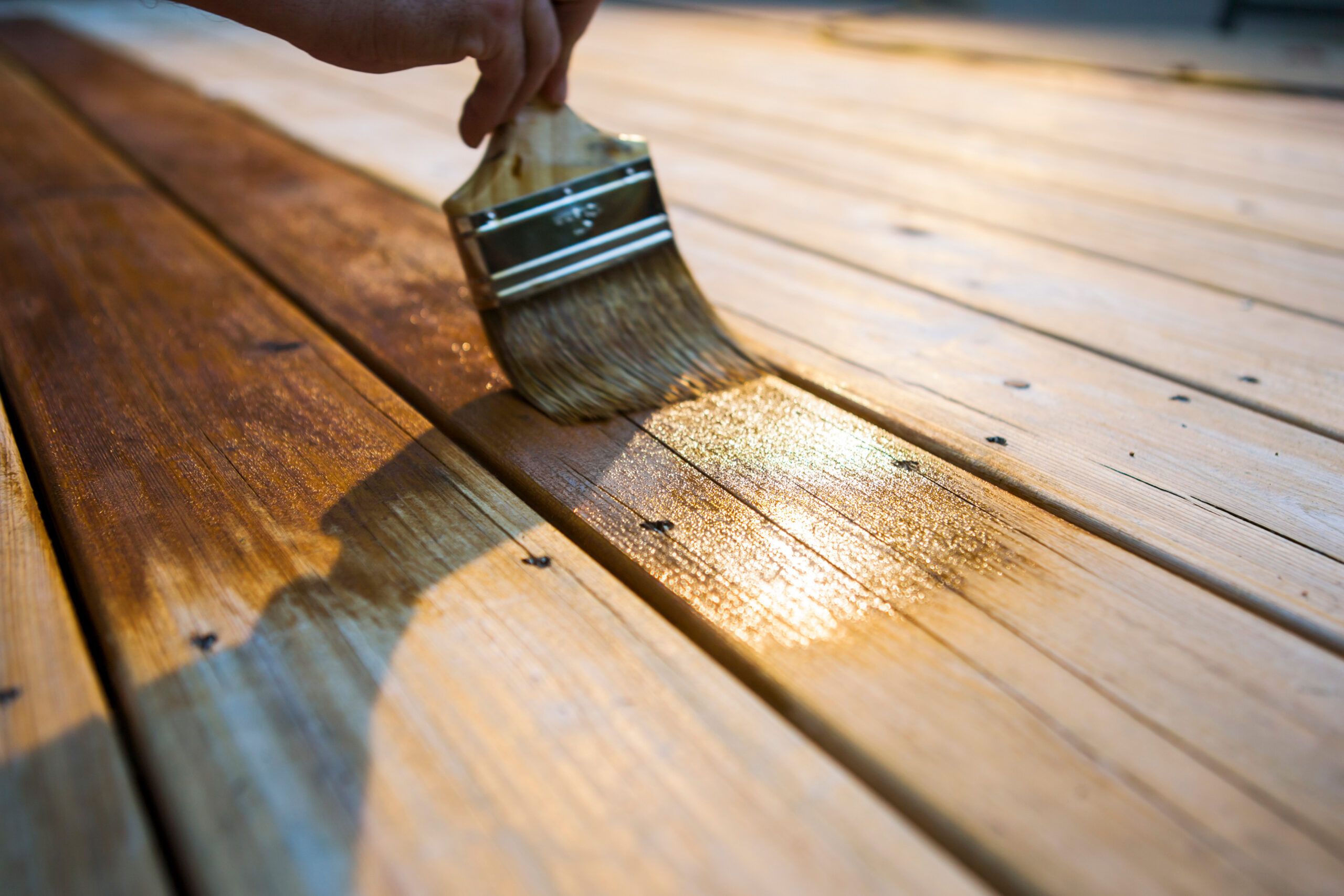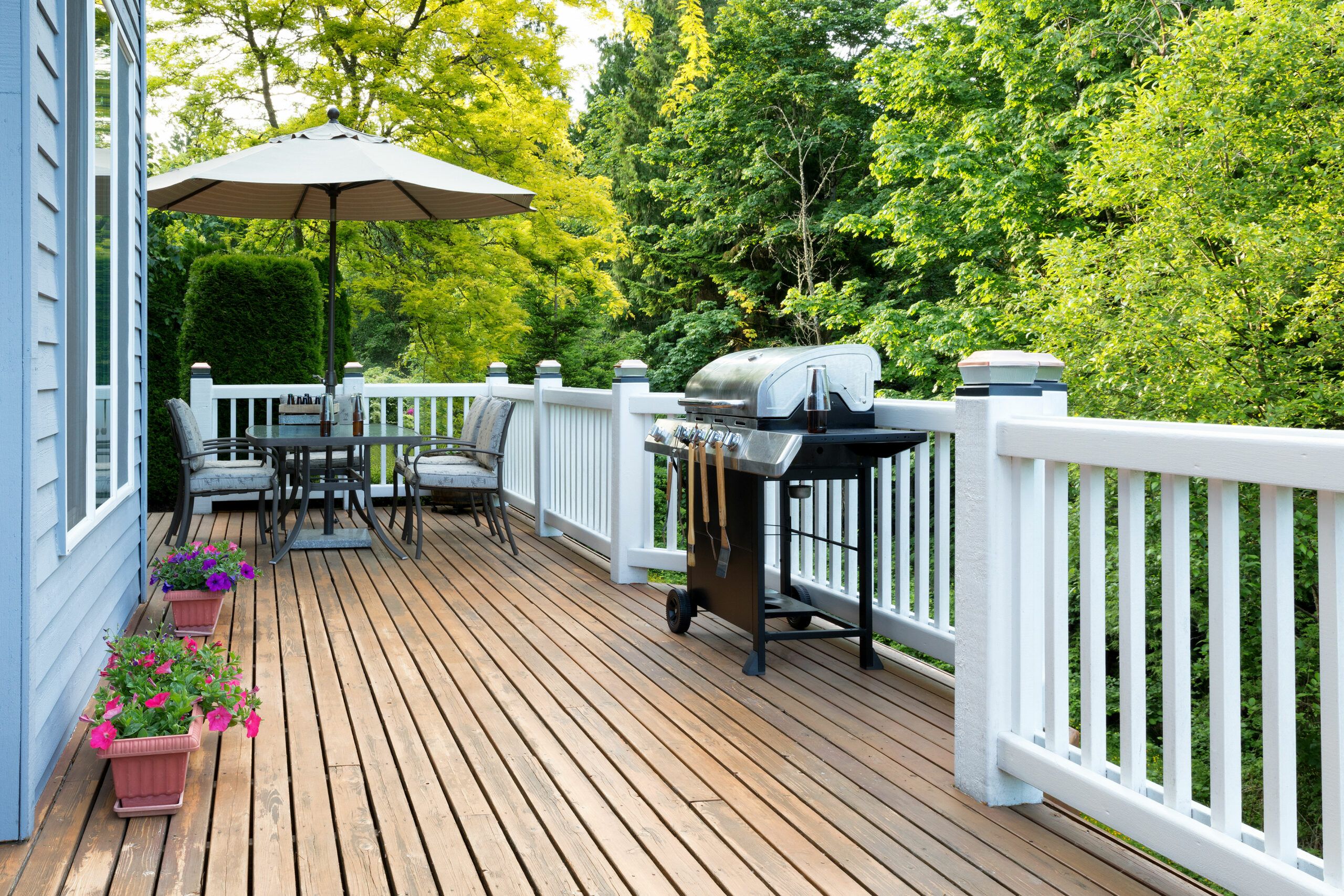A well-maintained deck can improve your home’s outdoor living space and increase its value. However, it requires regular maintenance to keep it safe and functional. Our guide will walk you through the do’s and don’ts of deck maintenance, from cleaning techniques to seasonal care.
Deck Maintenance Do’s
Here are the main things you should do to keep your deck properly maintained and safe.
Regular Cleaning and Inspection
Regular surface cleaning prevents dirt buildup, mold, and mildew, which can cause long-term damage. Inspect your deck for signs of wear and tear to help you identify and address issues before they become significant problems.
Clean your deck with appropriate cleaning solutions and tools to remove all debris. Inspect the deck for loose boards, protruding nails, and other potential hazards. Conduct these inspections and cleanings seasonally, or more frequently if needed.
Sealing and Staining

Sealing and staining your deck help prevent water damage, fading, and other forms of deterioration. When choosing products, consider the type of wood and the desired finish. Look for high-quality sealants and stains that offer long-lasting protection.
Start by cleaning the deck of accumulated grime. Once it is clean, you may want to apply borate to prevent algae and other microorganisms from building up. Wait two to three days after applying the borate to let it dry.
Once dry, check the deck for loose nails, splintering, and pockets of missing wood. For loose nails, hammer them back in place with a hammer and nail set. You can use a putty knife to get rid of any splintering and then sand down any rough patches of the deck. Finish up by adding wood putty or caulk in areas where there are gouges, cracks, or nicks to create an even surface. Let the wood putty dry for two to eight hours.
Once your deck is ready, you can begin staining, sealing, or painting it by following the manufacturer’s instructions, ensuring even coverage. Regularly reapply sealant and stain as needed, typically every one to three years depending on the product and environmental conditions.
Repairing Damaged Boards
Over time, deck boards can suffer damage due to weather, heavy use, or pest infestations, which can impact your deck’s structural integrity and appearance. Identify common types of damage, such as cracks, rot, or warping. Based on the severity of the damage and the overall condition of the deck, decide whether to repair or replace it.
With the right tools, homeowners can perform basic repairs, such as replacing a damaged board or securing loose nails. However, for more extensive damage, consider consulting a professional.
Deck Maintenance Don’ts
You’ll want to avoid doing these things to avoid damage to your deck.
Grilling on the Deck

Decks can be a great place to gather and have a splendid time with family. However, grilling on the deck may not be the safest idea. The paints or stains that you use on your deck could be flammable. Even if your deck doesn’t have paint or stain, the wood could ignite if flames touch the dry surfaces.
It is generally not recommended to grill on your deck. However, if you choose to, you should take safety precautions to prevent starting a potential fire. Keep a fire extinguisher nearby to put out any fire that may arise. Then place a fire-resistant grill mat between your grill and your deck to protect the wood from charcoal or embers that may fall onto the deck. Another option is to install fire-resistant decking and framing to minimize the possibility of fires on your deck.
Overuse of Pressure Washers
While pressure washers are great for cleaning decks, overuse can cause damage. Excessive pressure can strip away the wood’s surface and cause splintering. Use a pressure washer sparingly and opt for gentler cleaning methods when possible. If you must use a pressure washer, use the lowest effective pressure setting and keep the nozzle moving. Pressure washing your deck once a year should be sufficient to keep it looking great.
Neglecting Regular Inspections
Skipping routine inspections can lead to undetected issues growing into major problems. Regularly inspect your deck for signs of wear and tear, such as loose boards, protruding nails, or rot. Create and stick to an inspection schedule to catch potential problems early.
Using Improper Cleaning Products
Using inappropriate cleaning products can harm your deck. Harsh chemicals can strip the wood’s natural oils, while some products might not be effective on certain materials. Always use cleaners designed for your specific decking material and follow the manufacturer’s instructions.
Tools and Materials for Deck Upkeep
Having the right tools and materials on hand makes deck maintenance more manageable and effective. Below are tools and materials that you may need for cleaning, repairing, and protecting your deck.
- Cleaning solutions formulated for your deck material
- Scrub brush
- Broom
- Pump sprayer
- Hose
- Borate (optional)
- Sealants and stains
- Brushes
- Rollers
- Hammer
- Screwdriver
- Nails or screws suitable for your deck’s material
- Spare boards
- Gloves
- Safety glasses or goggles
- Knee pads
Deck Cleaning Techniques
Proper deck cleaning involves choosing the right methods and products to preserve the deck’s appearance and durability.
Choosing the Right Cleaner
Choosing the right deck cleaner depends on your deck’s material and the type of grime you need to remove. Common options include oxygen bleach cleaners and specialized wood cleaners. Consider environmental factors when selecting a cleaner to ensure it’s safe for children, pets, and plants.
Power Washing vs. Hand Scrubbing
Both power washing and hand scrubbing have their pros and cons. Power washing can remove tough stains and large debris but can be too harsh on softer woods. Hand scrubbing, though more labor-intensive, offers a gentler cleaning method for delicate surfaces. Use power washing for stubborn stains and hand scrubbing for routine cleaning.
When power washing, keep the pressure setting moderate and maintain a safe distance to avoid damaging the wood. For the best results, use a suitable brush and cleaner for hand scrubbing.
Drying and Post-Cleaning Care
After cleaning, allow your deck to dry thoroughly before applying any treatments. Drying prevents trapped moisture under sealants or stains, which could lead to mold growth. A post-cleaning inspection allows you to identify any new damage or issues that need attention. Once dry, your deck is ready for sealing or staining.
Protecting Your Deck from the Elements
Shielding your deck from environmental damage extends its life and maintains its good looks.
- Weatherproofing: Weatherproofing involves applying protective coatings that repel water and prevent damage. Depending on your location, you might need to weatherproof more frequently, especially in areas with high humidity or heavy rainfall.
- Sun protection: UV rays can damage your deck, leading to fading and cracking. Signs of sun damage include discoloration and splintering. Protect your deck by applying UV-resistant finishes and using outdoor furniture covers. If your deck is already sun-damaged, consider sanding and reapplying a finish to restore its appearance.
- Moisture prevention: Common moisture-related problems include warping, rot, and mold growth. To prevent moisture issues, seal your deck and make sure water can drain away efficiently. Regularly check for and address any signs of moisture damage promptly.
Seasonal Deck Care
Each season presents unique challenges for deck maintenance. Follow these seasonal care tips to keep your deck looking great year-round.
- Spring preparation: Check for damage caused by snow and ice and thoroughly clean the deck. Address any necessary repairs and apply a fresh coat of sealant or stain if needed to prepare for increased use.
- Summer maintenance: Protect your deck by addressing summer-specific issues such as grilling safety and increased foot traffic. Regularly clean the deck to remove debris and spills, and consider adding mats under heavy furniture to prevent damage.
- Fall winterization: As temperatures drop, clean the deck thoroughly to remove any leaf litter or dirt that could cause staining. Apply a waterproof sealant to protect the wood from snow and ice. Additionally, store deck furniture and accessories properly to prevent them from damage or damaging the deck surface.
Extending Your Deck’s Lifespan
Implementing additional measures can help prolong the life of your deck. Here’s how.
- Professional treatments: Sometimes, you may need professional services to keep your deck in prime condition. Consider professional treatments such as deep cleaning, sanding, and specialized coatings.
- Furniture and decor: Choose lightweight, weather-resistant furniture that won’t scratch or damage the deck surface. Place protective pads under heavier items and arrange planters thoughtfully to avoid water overflow. These precautions help maintain the deck’s integrity and reduce the need for repairs.
- Pest prevention: Pests can cause serious damage to your deck. Common pests include termites, carpenter ants, and wood-boring beetles. Regularly inspect your deck for signs of infestation and take preventive measures such as using treated wood and applying chemical deterrents.
Our Conclusion
Proper deck maintenance can preserve the beauty and functionality of your outdoor space. By following our do’s and don’ts of maintaining your deck, you can ensure your deck remains a safe and enjoyable extension of your home. For extensive damage, consider calling a professional.

